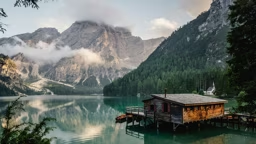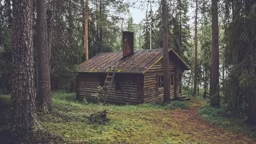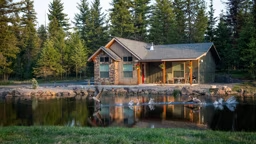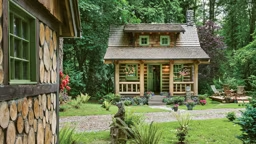It seems that everybody wants one – a vacation home, that is.
In the past, you were either born into one, you bought an existing one or you built one. But lately another option has been gaining ground – the Planned Unit Development (or PUD).
Whether it’s a collection of mountainside cabins in Montana or lakeside homes in Wisconsin, you’ve probably seen roadside signs for them on the drive to your vacation home. Or you’ve seen ads for them in your major metro newspaper.
PUDs have their critics and their supporters. Opponents often are existing cabin owners who fear that higher density developments will have negative consequences such as decreasing water quality or wiping out natural areas. Proponents will point out that PUDs are tightly controlled and may actually leave more natural resources undisturbed than a traditional development.
If you are concerned about a proposed PUD or contemplating ownership in one, read on.
What, Exactly, is a PUD?
Simply put, a PUD is a piece of property that is developed with privately owned cabins or residences, but jointly owned land and facilities. The developer proposes a plan (and hopefully a vision) that goes beyond a traditional subdivision.
One example is the conversion of an existing family-owned resort on a lake. Rather than raze the resort buildings and subdivide the property, the cabins are sold individually. The land and any recreational facilities are placed into an association jointly owned and controlled by the cabin owners.
Other PUDs are developed around a natural resource area that potential cabin owners would find highly desirable, such as an undeveloped waterfront property or a large forested parcel. The developer essentially builds a new community with individually owned cabins or even multiple family residences, but with community-owned open space and recreational facilities for all owners to enjoy.
In many cases a regulatory authority, such as a county, may allow a higher density of cabins in return for concessions such as leaving the majority of shoreline, forest or other natural area undeveloped and protected by easements, covenants or, in rare cases, public ownership. It may also allow other community facilities not found in traditional subdivisions: marinas, recreation/fitness centers or swimming pools, for example.
5 Questions to Ask
So, how can you tell if a planned development will be neighbor-friendly? Here are some questions to ask.
• Is new development efficiently clustered? Grouping cabins and facilities together preserves larger natural areas for owners to enjoy. It also limits disruption of wildlife and plants. And it makes other concerns – such as controlling runoff and treating sewage – more manageable.
• Are impervious surfaces limited? Hard, non-porous surfaces such as paved roads, driveways and building foundations can create soil erosion during development and increase water runoff once in place.
• Is community wastewater
treatment considered? Community or multiple residence wastewater treatment systems can utilize proven modern technologies custom fit to the site and local environment. These must be professionally designed, installed and maintained but can relieve individual owners of these critical responsibilities.
• Are future wastewater needs part of the plan? Individual wastewater treatment systems (such as septic systems) are needed in some developments. These will eventually need to be replaced even if properly maintained. Future treatment sites should be identified and protected.
• Are water conservation techniques used? Water conservation is important in arid or other areas where water supply is challenged. But any PUD can benefit from lower energy demands for heating and pumping, and less wastewater to treat. Carefully planned native landscapes can lower water use and other maintenance costs.
Also ask about visual screening, downlighting and buffer zones.
Proactive Associations
The owners’ association common to most PUDs is like a small city council. It makes rules, chooses contractors for maintenance work, operates the recreational facilities and can consider environmental factors in all of these. Some examples include:
• Solid waste collection. Contracting with one collection hauler limits truck traffic, noise and wear and tear on roads. Even better if the hauler also provides easy-to-use recycling services.
• Landscaping/grounds maintenance. An association can choose to specify environmentally friendly maintenance and landscaping techniques such as low-phosphorus fertilizers, minimum maintenance landscaping and minimal pesticide usage.
• Expert opinions. The staff of local Soil and Water Conservation Districts and University Extension Services are usually non-regulatory and eager to provide assistance, and sometimes funding, for environmental improvement projects. They can assist with projects like runoff-controlling rain gardens, lakeshore restoration, native plant selection and forest management.
• Local involvement. It’s a good idea for the association to maintain membership in a local conservation club or lake association.
• Volunteer opportunities. Many counties, watershed districts and state agencies are looking for volunteers to help with environmental monitoring programs. A PUD association is a logical source of volunteers.
Mike Lein has been working on local government land use and environmental issues for over 25 years – and has the gray hair and high blood pressure to prove it!
In the past, you were either born into one, you bought an existing one or you built one. But lately another option has been gaining ground – the Planned Unit Development (or PUD).
Whether it’s a collection of mountainside cabins in Montana or lakeside homes in Wisconsin, you’ve probably seen roadside signs for them on the drive to your vacation home. Or you’ve seen ads for them in your major metro newspaper.
PUDs have their critics and their supporters. Opponents often are existing cabin owners who fear that higher density developments will have negative consequences such as decreasing water quality or wiping out natural areas. Proponents will point out that PUDs are tightly controlled and may actually leave more natural resources undisturbed than a traditional development.
If you are concerned about a proposed PUD or contemplating ownership in one, read on.
What, Exactly, is a PUD?
Simply put, a PUD is a piece of property that is developed with privately owned cabins or residences, but jointly owned land and facilities. The developer proposes a plan (and hopefully a vision) that goes beyond a traditional subdivision.
One example is the conversion of an existing family-owned resort on a lake. Rather than raze the resort buildings and subdivide the property, the cabins are sold individually. The land and any recreational facilities are placed into an association jointly owned and controlled by the cabin owners.
Other PUDs are developed around a natural resource area that potential cabin owners would find highly desirable, such as an undeveloped waterfront property or a large forested parcel. The developer essentially builds a new community with individually owned cabins or even multiple family residences, but with community-owned open space and recreational facilities for all owners to enjoy.
In many cases a regulatory authority, such as a county, may allow a higher density of cabins in return for concessions such as leaving the majority of shoreline, forest or other natural area undeveloped and protected by easements, covenants or, in rare cases, public ownership. It may also allow other community facilities not found in traditional subdivisions: marinas, recreation/fitness centers or swimming pools, for example.
5 Questions to Ask
So, how can you tell if a planned development will be neighbor-friendly? Here are some questions to ask.
• Is new development efficiently clustered? Grouping cabins and facilities together preserves larger natural areas for owners to enjoy. It also limits disruption of wildlife and plants. And it makes other concerns – such as controlling runoff and treating sewage – more manageable.
• Are impervious surfaces limited? Hard, non-porous surfaces such as paved roads, driveways and building foundations can create soil erosion during development and increase water runoff once in place.
• Is community wastewater
treatment considered? Community or multiple residence wastewater treatment systems can utilize proven modern technologies custom fit to the site and local environment. These must be professionally designed, installed and maintained but can relieve individual owners of these critical responsibilities.
• Are future wastewater needs part of the plan? Individual wastewater treatment systems (such as septic systems) are needed in some developments. These will eventually need to be replaced even if properly maintained. Future treatment sites should be identified and protected.
• Are water conservation techniques used? Water conservation is important in arid or other areas where water supply is challenged. But any PUD can benefit from lower energy demands for heating and pumping, and less wastewater to treat. Carefully planned native landscapes can lower water use and other maintenance costs.
Also ask about visual screening, downlighting and buffer zones.
Proactive Associations
The owners’ association common to most PUDs is like a small city council. It makes rules, chooses contractors for maintenance work, operates the recreational facilities and can consider environmental factors in all of these. Some examples include:
• Solid waste collection. Contracting with one collection hauler limits truck traffic, noise and wear and tear on roads. Even better if the hauler also provides easy-to-use recycling services.
• Landscaping/grounds maintenance. An association can choose to specify environmentally friendly maintenance and landscaping techniques such as low-phosphorus fertilizers, minimum maintenance landscaping and minimal pesticide usage.
• Expert opinions. The staff of local Soil and Water Conservation Districts and University Extension Services are usually non-regulatory and eager to provide assistance, and sometimes funding, for environmental improvement projects. They can assist with projects like runoff-controlling rain gardens, lakeshore restoration, native plant selection and forest management.
• Local involvement. It’s a good idea for the association to maintain membership in a local conservation club or lake association.
• Volunteer opportunities. Many counties, watershed districts and state agencies are looking for volunteers to help with environmental monitoring programs. A PUD association is a logical source of volunteers.
Mike Lein has been working on local government land use and environmental issues for over 25 years – and has the gray hair and high blood pressure to prove it!
What's in your back yard?
What’s good for a planned unit development is also good practice for individual properties. Here’s an individual property owners’ checklist:
• Do you know where your septic system is and when it was last maintained?
• Are parts of your property or shoreline restored to or left in a natural state?
• Have you considered volunteering to monitor your lake quality or joining a local conservation group?
• Does your ATV tread lightly and is it driven on the trails on public land?
• Do you educate guests to observe no-wake restrictions when on the water?
What’s good for a planned unit development is also good practice for individual properties. Here’s an individual property owners’ checklist:
• Do you know where your septic system is and when it was last maintained?
• Are parts of your property or shoreline restored to or left in a natural state?
• Have you considered volunteering to monitor your lake quality or joining a local conservation group?
• Does your ATV tread lightly and is it driven on the trails on public land?
• Do you educate guests to observe no-wake restrictions when on the water?
 Hidden Meadow Ranch, www.hiddenmeadow.com
Hidden Meadow Ranch, www.hiddenmeadow.com  Hidden Meadow Ranch, www.hiddenmeadow.com
Hidden Meadow Ranch, www.hiddenmeadow.com 









